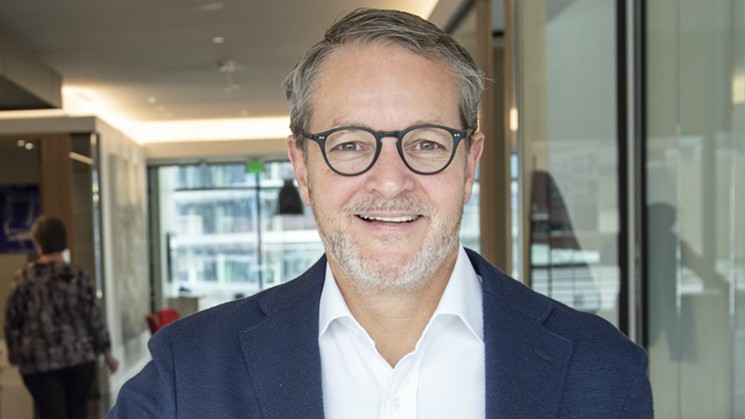Mark Falcone, founder and CEO of Continuum Partners, the force behind a slew of significant mixed-use projects in metro Denver, including Belmar in Lakewood, feels this achievement is the direct result of a philosophical pivot in development that he and others began pushing decades ago, and its impact has been enormous.
"Downtown Denver has 30,000 more jobs than it did in 2010," says Falcone, who is currently working on Market Station, which will boast 85,000 square feet of retail, 90,000 square feet of office and 225 market-rate apartments on a two-acre Blake Street plot. "That's something like a 25 to 30 percent increase in the number of employees downtown. The area has also gained a significant market share in high-value office space as a consequence of concentrating on access and mobility, as well as transit, which is really reshaping our urban form."
"Foot Traffic Ahead 2019" was released under the auspices of Smart Growth America, a nonprofit that advocates for "economically strong, socially equitable and environmentally sustainable communities." Its authors examined the thirty largest U.S. metro areas based on the percentage of office, retail and rental multi-family space in walkable urban areas, measuring the impact on rents, sale prices, social equity and more in the process. The idea was to both document and further encourage the move away from developments such as suburban office parks that are mainly accessed by automobiles and toward projects that folks are able to reach using public transportation, bicycles or their legs alone.
Denver did well in a slew of Smart Growth America metrics, including those provided by Walk Score, which assigns numerical grades through 100 for addresses based on the time the average person needs to walk to amenities such as fresh food. Falcone says some investors these days won't put their money into any building that doesn't record a 70 or above on Walk Score.
The Mile High City finished second overall in the amount of walkable urban-square footage for income properties, with such spaces scoring a 96 percent rental-rate premium per square foot over metro-area real estate in general. Only New York City did better. Likewise, Denver tied for second with Boston in terms of walkable urban absorption; the latter term is defined as the rate at which available properties are sold over a given time period. And it was eighth regarding future indicators of walkable urbanism development, in part because the market share for those driving-centric places has fallen precipitously in Denver over the previous eight years.
"The last time market share shifts of this magnitude occurred in the region was when drivable suburban development was gaining market share at this rate in the 1980s…but in the opposite direction," a summary of the Denver digits reveals.
The news isn't all good. Denver was ninth in social equity largely because light rail and other public transportation options have not yet reduced transportation costs for low-income residents by as much as at least eight other major cities. And Falcone acknowledges that there have been winners and losers in Denver's ongoing development boom.
"Within the city, there's a lot of disruption now because investment capital has poured into our community so quickly that it's displacing people," he notes. "We have to wrestle with that as a community, and as people who live inside these mechanisms, the solutions won't be simple."
Still, Falcone, who is serving as Smart Growth America's Denver expert during the roll-out of "Foot Traffic Ahead," is bullish on the findings.
"What these guys are doing is cataloguing the data in a very interesting way to prove to investors that these principles are actually performing better economically right now," he allows. "We believed that and were asserting it based on our observational experience. But these guys have data that proves it in a very profound way."
For Falcone, the facts and figures stand as confirmation that he's been on the right track.
"I set up Continuum in 1997 specifically to focus on trying to mobilize more capital and push more development into center-city walkable neighborhoods, and to create more walkable kinds of projects even in the case of some suburban development," he recalls.
Today this mission seems prescient, but Falcone admits that "you don't always get rewarded in our business for being early. I was trying to advance these principles in the first half of the 1990s through a development enterprise I was associated with back in upstate New York. Back then, there were zoning and planning practices that precluded these kinds of mixed-use projects from going forward, and it was hard to educate village boards in an older part of the country to change their ordinances to allow for this stuff. That's one of the reasons I came to Denver in ’97 — because I felt this was a region of the country that would be more receptive."
Not every Denver official was convinced, either — but Continuum managed to get the resources together to build 16 Market Square. "It's on 16th between Market and Blake," he explains, "and the zoning ordinance that was put in place in the 1980s allowed us to get density bonuses by building residential and office together. It was the first building that really fully exploited the extended bonus opportunity: a 200,000-square-foot office building with 25 residential condos on top that took advantage of a neighborhood that was really walkable. When we completed the building in 1999, most of the tenants in that building came from high-rise floors of buildings from farther up downtown who'd been awakened to the value of the highly activated, walkable neighborhood LoDo represented."
As Falcone sees it, such developments are "essential from an ecological standpoint." However, he also likes to speak about what he calls "human ecology," which he explicates by discussing the origins of Belmar, a development built on the grounds of Villa Italia, a once thriving mall that had fallen on hard times.

Continuum Partners transformed the dying Villa Italia mall into Belmar.
Continuum Partners/City of Lakewood via YouTube
Continuum's pitch to redevelop the land was nothing if not ambitious. Falcone reveals, "We said, 'We want to create an infrastructure that will allow those 104 acres to add value to the neighborhood around it so that it will be attractive and durable for decades — maybe even 100 years."
He saw Villa Italia as "a battleship. It was kind of impenetrable. You couldn't maneuver your way through it. So we broke it up into thirty city blocks. It didn't matter what was on each block, and there were changes through the process: The space where the Target is was supposed to be more residential, and the Whole Foods was supposed to be office space. But once we had a good, walkable grid, we were able to give the physical environment a lot of permeable connections and mobility options — and we made sure to keep them very walkable on a human scale. That meant worrying about sidewalk design, worrying about trees, worrying about a lot of little signals that were calculated to subconsciously tell you, 'This is a good place to walk.'"
Transportation options such as light rail further enhance the appeal of walkable spaces, Falcone says — and he sees the changes in the Denver Tech Center as illustrating the effect.
"In the late ’90s and early 2000s, the highest-value office space along the I-25 corridor were the buildings in the heavily manicured office parks on the east side of the highway," he maintains. "Now it's the office projects on the west side. Twenty years ago, they were considered the value properties: If you couldn't afford the big, beautiful office park on the east side, you could go to them. But now the west side is being serviced by transit ,and you have these nodes of urban fabric that are dense use and walkable — and employers now see that as having more appeal to their employees than the somewhat sterile office parks on the east side, which are almost economically obsolete now. They may be beautiful buildings, but they don't draw the same tenant interest as the properties located on these transit platforms. That's a big shift in the way Denver has been going."
And those growing pains? Falcone isn't concerned. "We work in a lot of different parts of the west, so we know that Denver is working as hard on these issues as anywhere. I'm convinced Denver will once again be able to lead the nation in some of these solutions, and I'm excited that we have them as an opportunity partner."
One that knows the value of taking things step by step.
Click to read "Foot Traffic Ahead."













